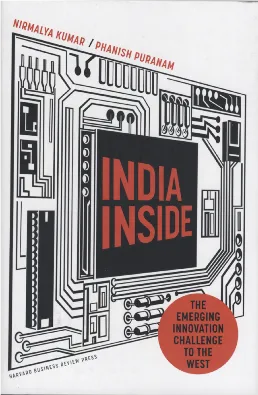[Book Review] India Inside: The Emerging Innovation Challenge to the West

2012 Harvard Business Review Press (Amazon)
8 chapters; 177 pages
For certain kinds of innovation, the long-held monopoly of the developed world as compared to the developing world is over, according to management experts Nirmalya Kumar and Phanish Puranam.
Through their research and extensive interviews with India-based executives from such companies as AstraZeneca, GE, Infosys, Intel, and Wipro, as well as a range of entrepreneurs in India, the authors unveil the rise in ‘invisible’ innovation occurring in India — from B2B products and R&D outsourcing to process and management innovation. The book also illuminates Indian companies’ growing strength in frugal engineering: consumer products that are compact, low-cost, efficient, and robust in the face of harsh environmental conditions.
Nirmalya Kumar and Phanish Puranam are professors at London Business School and serve as co-directors of its Aditya Birla India Centre. They have authored numerous books and articles on marketing, innovation, strategy, and Indian business. This book builds on the work of C.K. Prahalad (‘bottom of the pyramid’) and Vijay Govindarajan (reverse innovation) as well as others who have written about frugal innovation, eg. see my book review of Jugaad Innovation and my interview with its co-author Navi Radjou.
“Where are the Indian Googles, iPods and Viagras?” the authors provocatively ask in the first chapter of the book. There are none – at least not yet; there are few instances of globally recognised products and services from India, but the contribution of India is ‘invisible’ in the form of embedded support for R&D and business processes. The authors refer to this as ‘India Inside,’ drawing on the ‘Intel inside’ branding of computer products. Many of the ‘visible’ products and services from India are designed largely for the local market, but some of these are now appearing in other emerging economies and even back in the mature economies.
The book raises provocative questions for Indian tech players, policymakers, innovators and entrepreneurs. I wonder if the rise of the new generation of startups here will lead to the ‘India Outside’ phenomenon – products and services which become global brands and have a distinct and proud Indian stamp! The mix of re-pats (returning global Indians), young entrepreneurs and experienced corporate managers joining innovators these days bodes well for ‘India Outside’ startups.
In Table 1 below, I have summarised the authors’ distinction between visible and invisible innovation, as well as the four types of invisible innovation from India. The book devotes a full chapter to each of these types of innovation, and also provides recommendations to MNCs and policymakers on the consequences and strategies for harnessing such innovation strengths in India.
Table 1: Innovation Types and Examples in India
Paradoxically, the move from invisible to visible innovation may not be necessary or possible for many Indian companies, due to reasons of contractual ties with their outsourcing partners, or lack of incentive, or less willingness to take risks in global product/service development.
The availability of low-cost high-quality talent in India has led to re-innovation in sectors previously considered mature or low-tech in the West. India was seen as a lagging market for decades across sectors, but is now becoming a lead market in sectors like telecommunications, eg. see my interview with V.S. Sridhar, author of The Telecom Revolution in India.
The global service delivery model pioneered by Indian service companies is regarded by some to be as significant as Henry Ford’s assembly line model, the TQM movement, or DuPont’s multidivisional form of organisation. Other management innovations from the past include R&D labs, Six Sigma, and Japanese companies’ successes in harnessing the problem-solving skills of its first-level employees.
Key elements of frugal engineering are robustness, portability, simplicity (de-featuring) and service ecosystems. Once such products are designed and tested in India, mega-production can further bring down unit costs.
Xerox has hired innovation managers to search for mobile startups in India and learn from their innovations, and HP’s research lab in India is testing mobile Web apps here to see if they can be used for developed markets as well.
More material on such startups and their offerings could have been included in this book. B2B product innovation is also emerging in India, such as the Finacle banking product from Infosys, and its Magic Mirror solution for retailers.
Lessons from frugal engineering can also be applied to other sectors, the authors argue – such as improving the efficiency of public services in the West.
The authors also compare the innovation profiles of India and China. MNCs have captive in-house R&D units in India as well as China, but Indian subsidiaries are pursuing projects which are more global than those in China. Also see my book review of China Fast-Forward and my interview with the author, Bill Dodson.
Countries like India and especially China may well lead in future in industrial innovations (eg. electronics products) but will find it harder to match the lead of the West in pure science and pharmaceuticals (though China is moving better and faster in this area than India).
The West also has a leading consumer advantage: its consumers are more willing to try out new products. They also are more sophisticated, eg. German automobile buyers, French and Italian consumers of fashion.
Emerging trends include sinking skill ladders in the West as lower-rung positions move to emerging economies, ‘browning’ of the top management teams as MNC centres shift towards Asia, and the rise of global players from India and China (as with the rise of players from Japan and Korea a few decades ago).
The West will also have to take steps to preserve knowledge about outsourced competencies, or they will be eventually lost and it will be Asian companies who innovate and gain in these sectors. Some observers have noted that off-shoring CRT TV production by the West helped Korean and Japanese players to innovate their way into flat screens (plasma, LCD, LED) and solar film production.
The West still leads in world-class universities, ties between universities and industry, and generous government funding for public science – but will need to encourage more students to pursue science and technology, and promote harder work ethics.
The West will also have to address the reverse brain drain as Indian talents return home (‘repats’), and should make it easier, not harder for skilled entrepreneurs to immigrate to the West. This issue is also addressed by researchers such as Vivek Wadhwa - see my book review of Immigrant Exodus.
In the long term, key innovation challenges for India will arise not just in poor infrastructure or corrupt government, but inadequate venture financing, IP protection and quality/size of talent pool. There are serious shortages in PhDs and gaps in industry relevance of higher education.
The education system is also siloed, and hampers the development of inter-disciplinary skills, eg. in medicinal chemistry, which is a mix of biology, mathematics and chemistry – but mathematics and biology are split after ninth standard in Indian schools! India should also do more to attract foreign talent from around the world, thus giving local entrepreneurs better insights into technology and markets overseas.
The ‘venture’ also needs to be put back into venture capital in India, and not just focus on ‘scaling up coffee chains.’ Fortunately, VCs like Sequoia, Helion and the Indian Innovation Fund are stepping into this gap. Successful startups from India now include Zoho, InfoSoft Global, InMobi and FusionCharts, eg see my interview with Pallav and Sanket Nadhani of FusionCharts.
Looking to the future, the authors observe that as compared to the other Asian giant, China, India has a more democratic culture and a stronger youth dividend. “Our message to the world is, embrace it,” the authors conclude.
[Follow YourStory's research director Madanmohan Rao on Twitter at @MadanRao]


![[Book Review] India Inside: The Emerging Innovation Challenge to the West](https://images.yourstory.com/cs/wordpress/2012/10/IndiaInside.png?mode=crop&crop=faces&ar=16%3A9&format=auto&w=1920&q=75)




